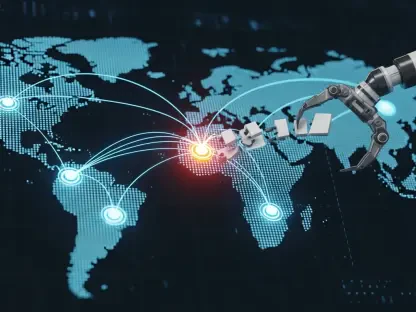As cyber threats evolve, U.S. industries are constantly under pressure to adapt and implement robust measures against sophisticated cyberattacks that target critical infrastructures. The advent of advanced malware like LummaC2 has forced companies to reassess traditional cybersecurity approaches and deploy more comprehensive defense strategies. LummaC2, an infostealer malware, poses a significant threat to infrastructure sectors by exfiltrating sensitive information without easy detection. Its appearance on Russian-language cybercriminal forums and subsequent deployment via spearphishing attacks highlights the vulnerabilities industries face. To effectively thwart these threats, U.S. industries prioritize constant vigilance, robust cybersecurity frameworks, and collaboration among government agencies and private sectors. Ensuring the protection of sensitive information across various infrastructure sectors requires a multi-faceted approach that continues to evolve with emerging threats.
Emerging Malware Threats
The accumulation of emerging and evolving malware threats such as LummaC2 has significantly altered the landscape of cybersecurity challenges facing U.S. industries. Originating on illicit forums, LummaC2 targets businesses across critical sectors by employing sophisticated methods, including obfuscation techniques and malicious links embedded in legitimate-looking messages. As the threat landscape becomes more complex, understanding these tactics is essential for businesses and cybersecurity professionals to implement effective countermeasures.
LummaC2’s ability to bypass Endpoint Detection and Response solutions has raised concerns regarding the adequacy of current cybersecurity measures. By embedding itself in spoofed software, this malware can evade standard detection protocols and infiltrate systems without triggering alerts. Once inside, it can exfiltrate vital user information, from financial credentials to browser extensions and Multi-Factor Authentication details. This calls for industries to not only invest in advanced detection technologies but also ensure that employees are aware of potential threats through comprehensive training and awareness programs. As cybercriminals continue to refine their strategies, such as disguising payloads in fake CAPTCHAs and leveraging spearphishing techniques, U.S. industries must remain agile and proactive in enhancing their cyber defenses against these potential breaches.
Government and Private Collaboration
In response to ever-evolving cyber threats, cooperation between government agencies and private sectors has become an essential cornerstone of modern cybersecurity strategies. Agencies like the FBI and CISA play a critical role in disseminating information related to known Threat Tactics and Procedures (TTPs) and Indicators of Compromise (IOCs). By collaborating closely with industry leaders, they help ensure that vulnerable sectors are informed and equipped to defend against threats like LummaC2.
This collaboration leverages the unique insights and resources from different stakeholders to enhance overall security readiness. Government advisories and detailed analyses of cyber threats provide businesses with a foundation for strengthening their cybersecurity practices. Such partnerships encourage a proactive approach, where sharing threat intelligence helps industries to stay a step ahead of potential attacks. Implementing shared insights from these collaborations fosters an adaptive defense posture, significantly reducing the chances of successful intrusion by cyber adversaries. As cyber threats continue to multiply and transform, ongoing collaboration remains key to maintaining a resilient infrastructure that can withstand evolving threats.
Preparing for the Future
Industries understand that preparing for the future of cybersecurity requires an acknowledgment that threats will continue to evolve, becoming more sophisticated with each passing year. By adopting a forward-thinking approach, businesses can ensure the continuous adaptation of their defenses to meet the growing complexities of cyber threats. Implementing advanced technologies, such as Artificial Intelligence and Machine Learning in threat detection, can provide a proactive edge in identifying and mitigating risks before they become full-blown attacks.
Organizations are also investing heavily in cybersecurity research and development to design new solutions that integrate seamlessly into existing systems. By staying abreast of technological advancements and fostering innovation, they are better positioned to anticipate and neutralize potential threats. It is crucial for industries to maintain a balance between leveraging cutting-edge technology and instilling a culture of cyber vigilance within their workforce. This involves regular training sessions, simulations, and exercises designed to foster awareness and preparedness. As the future unfolds, a comprehensive and integrated approach will prove indispensable in mitigating advanced cyber threats.
Conclusion: Leading the Charge
The rise of sophisticated malware like LummaC2 is reshaping cybersecurity challenges for U.S. industries. Emerging from illicit forums, LummaC2 targets businesses in essential sectors using advanced tactics, such as obfuscation and inserting malicious links in legitimate-looking communications. As cybersecurity threats grow in complexity, it’s crucial for organizations and experts to grasp these methods to devise effective defenses.
LummaC2’s capacity to circumvent Endpoint Detection and Response tools has intensified worries about the effectiveness of current cybersecurity systems. By embedding in fake software, this malware evades standard protocols, infiltrating systems without setting off alarms. Once inside, it steals crucial user data, including financial info, browser extensions, and Multi-Factor Authentication details. Consequently, industries need to invest in cutting-edge detection tech and train employees to recognize threats. As cybercriminals perfect strategies like hiding payloads in false CAPTCHAs and utilizing spearphishing, U.S. industries must stay adaptable and proactive to bolster their defenses against breaches.









